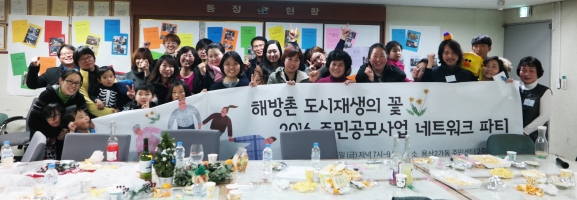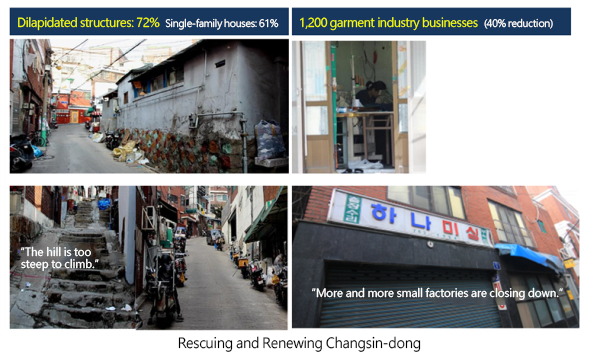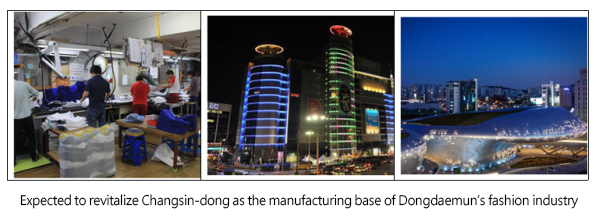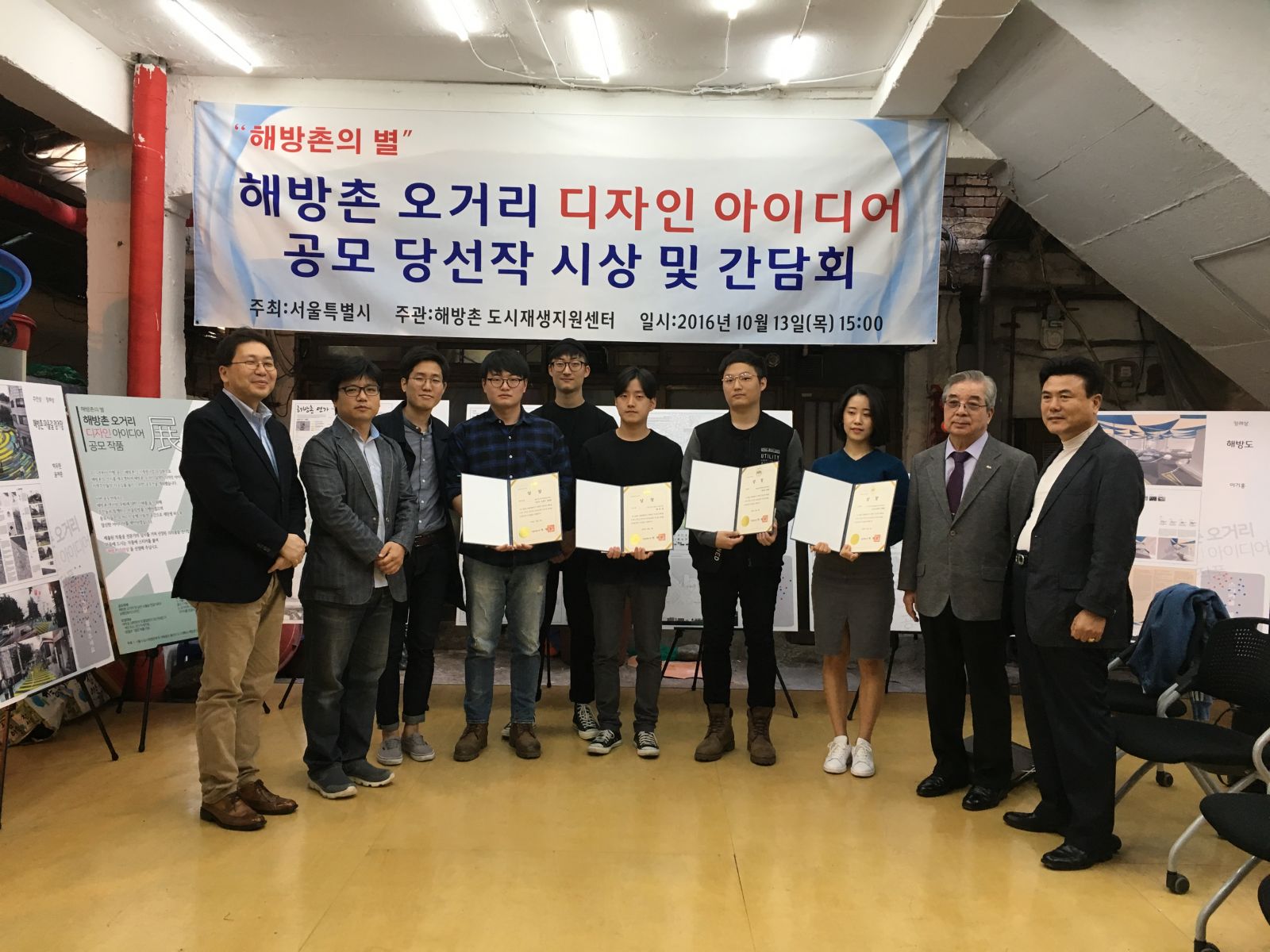제목배경이미지:  Seoul's Urban Regeneration Model
Seoul's Urban Regeneration Model
제목배경이미지:

Background: Challenges & Objectives
From the 1950 to the early 2000s, Seoul, as the capital of the Republic of Korea, experienced industrialization and rapid growth, which led to a rapid population increase and large-scale expansion of the city. During this period, real estate became a means of quickly amassing property and wealth, giving rise to reckless housing improvement projects, such as redevelopment and reconstruction involving the complete demolition of older areas. The side effects included a marked tendency to place value on property rather than on people, the loss of local characteristics due to the destruction of communities, and damage to the natural landscape. While the profits from such developments were returned to developers and speculative investors, the socially vulnerable and destitute, unable to pay the high prices of new apartments or bear the additional burden of development, were driven out of their homes to the outskirts of the city, where they encountered a lower quality of life and poorer housing.
Meanwhile, household debt increased due to real estate speculation, which inevitably led to a decrease in consumption and a vicious economic cycle. The rise in property value and rental prices due to the development of entire regions also caused other social problems, such as gentrification.
“Gentrification” refers to a situation in which old residential or commercial areas originally occupied by lower-income families are renovated to suit middle-class families wanting to move in, which in turn drives up rent, resulting in the displacement of the original residents by people with a higher income. There are some positive effects of this phenomenon, such as the vitalization and improvement of local communities. However, some of the negative effects include forced displacements of original residents due to the influx of people from different regions, which has the added effect of reducing the diversity and sustainability of the communities concerned and a weakening of the city’s competitiveness. Therefore, the establishment and implementation of measures to counter these negative impacts has become a key challenge in the process of carrying out urban regeneration projects.
Meanwhile, household debt increased due to real estate speculation, which inevitably led to a decrease in consumption and a vicious economic cycle. The rise in property value and rental prices due to the development of entire regions also caused other social problems, such as gentrification.
“Gentrification” refers to a situation in which old residential or commercial areas originally occupied by lower-income families are renovated to suit middle-class families wanting to move in, which in turn drives up rent, resulting in the displacement of the original residents by people with a higher income. There are some positive effects of this phenomenon, such as the vitalization and improvement of local communities. However, some of the negative effects include forced displacements of original residents due to the influx of people from different regions, which has the added effect of reducing the diversity and sustainability of the communities concerned and a weakening of the city’s competitiveness. Therefore, the establishment and implementation of measures to counter these negative impacts has become a key challenge in the process of carrying out urban regeneration projects.
Actions & Implementation
To overcome the negative side effects of the previous approach of demolishing older buildings to make way for new apartment complexes, the Seoul Metropolitan Government (SMG) sought an alternative approach beginning in the early 2010s. It established an Urban Regeneration Headquarters, which has since been working hard on devising systematic measures for transforming Seoul into a people-centered city.
The government focused on developing an urban regeneration model for comprehensive, sustainable housing that is based on promoting the active participation of residents and encouraging them to pursue self-sufficiency. This approach consists of maintaining existing communities and settlement environments, strengthening communities, and establishing the basis for a self-sufficient local economy led by the residents themselves. In addition, it entails “preventive measures against forced demolition” to protect the socially vulnerable and poor residents.
The establishment of a cooperative system involving the government, civil organizations and schools, as well as the SMG’s signing of MOUs with universities and civil organizations in urban regeneration areas, made it possible to execute urban regeneration projects while reducing the gentrification phenomenon and other side effects of urban development.
The government focused on developing an urban regeneration model for comprehensive, sustainable housing that is based on promoting the active participation of residents and encouraging them to pursue self-sufficiency. This approach consists of maintaining existing communities and settlement environments, strengthening communities, and establishing the basis for a self-sufficient local economy led by the residents themselves. In addition, it entails “preventive measures against forced demolition” to protect the socially vulnerable and poor residents.
The establishment of a cooperative system involving the government, civil organizations and schools, as well as the SMG’s signing of MOUs with universities and civil organizations in urban regeneration areas, made it possible to execute urban regeneration projects while reducing the gentrification phenomenon and other side effects of urban development.
By introducing a regeneration initiative that involves citizens, the SMG was able to combine the unique historical, cultural, and social assets of different regions and enhance their communities’ vitality and the pursuit of happiness through the “rediscovery of forgotten values.”

Description :Before Renewing Changsin-dong
Source: SMG

Description : The processes of residential participation
Source: SMG

Description : After regenerating Changsin-dong
Source: SMG
To sum up, this initiative has helped create a foundation for sustainable communities by stabilizing the housing environment for the socially vulnerable, ensuring the preservation of assets with historical, cultural, and social value, and enhancing local communities by improving their environment.
Results & Evaluation
With the transformation of the city’s development paradigm into the community regeneration initiative, it became possible to protect the housing of the socially vulnerable and lay the foundation for sustainable communities.

Description: Residential Network Party
Source: SMG
Of the 683 areas across Seoul that were expected to be redeveloped and reconstructed, 328 became regeneration projects with the focus on preserving local values and landscapes. (These areas include the Changsin and Sungin-dong apparel industry village, the Ihwa and Chungsin-dong Seoul City Wall mural village, and the Haengchon-dong fortress village urban farming project.)

Description: Won design award for a design idea on the five-way intersection in Haengchon-dong
Source: SMG
Previous redevelopment and reconstruction projects offered little protection for the socially vulnerable or their right to housing, as forced demolition was legally allowed if over 75 percent of the residents agreed to it. For the first time in Korea, however, the SMG adopted strong and “comprehensive preventive measures against forced demolition” in order to systematically provide a social safety net that protected the housing rights of the socially vulnerable (such as the residents of the Muak-dong Okbaraji History and Culture Street).
In eight housing regeneration/revitalization areas, as well as 22 neighborhoods in nine regions, the SMG provided support for regeneration projects tailored to the characteristics of those areas and for the establishment of neighborhood enterprises capable of achieving economic self-sufficiency. The SMG also supported a joint exhibition and sales of representative products from 53 enterprises in 24 regeneration areas. By implementing housing regeneration initiatives tailored to each area, it was possible to lay a solid foundation for sustainable and economically self-sufficient communities while preserving the historical and cultural assets of all of the areas concerned.

Description: Residential Network Party
Source: SMG
Of the 683 areas across Seoul that were expected to be redeveloped and reconstructed, 328 became regeneration projects with the focus on preserving local values and landscapes. (These areas include the Changsin and Sungin-dong apparel industry village, the Ihwa and Chungsin-dong Seoul City Wall mural village, and the Haengchon-dong fortress village urban farming project.)

Description: Won design award for a design idea on the five-way intersection in Haengchon-dong
Source: SMG
Previous redevelopment and reconstruction projects offered little protection for the socially vulnerable or their right to housing, as forced demolition was legally allowed if over 75 percent of the residents agreed to it. For the first time in Korea, however, the SMG adopted strong and “comprehensive preventive measures against forced demolition” in order to systematically provide a social safety net that protected the housing rights of the socially vulnerable (such as the residents of the Muak-dong Okbaraji History and Culture Street).
In eight housing regeneration/revitalization areas, as well as 22 neighborhoods in nine regions, the SMG provided support for regeneration projects tailored to the characteristics of those areas and for the establishment of neighborhood enterprises capable of achieving economic self-sufficiency. The SMG also supported a joint exhibition and sales of representative products from 53 enterprises in 24 regeneration areas. By implementing housing regeneration initiatives tailored to each area, it was possible to lay a solid foundation for sustainable and economically self-sufficient communities while preserving the historical and cultural assets of all of the areas concerned.
Expectancy effects & Need for Improvement
As regards the SMGs urban regeneration initiative, a systematic 10-year plan titled “2025 Urban Regeneration Strategy” was created in the course of a year (from March 2015 to December 2015). In addition, a mid- to short-term plan titled “Urban Regeneration Revitalization Plan” was established for thirteen areas in Seoul as part of the master plan for the sustainable urban regeneration initiative.
In the implementation stage, over fifty civilian experts selected as “conflict mediation coordinators” were first sent to conflict-ridden development areas. They monitored these areas over 500 times throughout the year to provide customized solutions and decisions on the progress. Moreover, alternative projects were sought with the focus on preserving regional values, including the communities themselves, cultural assets, and natural landscapes.
In addition, urban regeneration support centers were established in eight housing regeneration areas in Seoul (Changsin/Sungin, Haebangchon, Garibong, Sinchon, Seongsu, Jangwi, Sangdo, and Amsa-dong) to facilitate communication among the administration, local residents, and stakeholders. Meanwhile, master planners and activists were dispatched to onsite centers to actively support the implementation of the urban regeneration initiative.
Furthermore, the SMG bought and renovated anchor facilities for the regeneration/revitalization areas and made them available for use as bases for local residents’ economic, cultural and social activities free of charge. The SMG also provided support to help the residents achieve economic self-sufficiency in operating the facilities, thereby laying the basis for the formation of sustainable and self-sufficient communities.
Nineteen areas received support for implementing resident-led initiatives involving meetings with about 1,600 residents. In addition, 140 education and training classes were provided annually to over 3,000 residents in regeneration areas to strengthen their capacity for self-sufficiency. Educational and training programs designed to discover and foster “regeneration activists” produced over 120 regeneration activists every year, who were dispatched as mentors to assist the residents of regeneration areas.
To establish a sustainable and self-sufficient economic basis, the SMG also provided consulting services on the development of products that represent regional characteristics. Through these efforts, 53 neighborhood enterprises and cooperative associations in 23 areas received support, including joint marketing events to promote their products, as a means of establishing the basis for the residents’ self-sufficient economy.
Moreover, the SMG developed a comprehensive diagnosis and monitoring system for regeneration projects and enhanced their implementation through systematic management, comprehensive evaluation, and feedback. For the successful implementation of the regeneration projects, the SMG’s Urban Regeneration Headquarters invested KRW 195 billion in such projects in 2016, and has plans to invest about KRW 231 billion this year as well.
In the implementation stage, over fifty civilian experts selected as “conflict mediation coordinators” were first sent to conflict-ridden development areas. They monitored these areas over 500 times throughout the year to provide customized solutions and decisions on the progress. Moreover, alternative projects were sought with the focus on preserving regional values, including the communities themselves, cultural assets, and natural landscapes.
In addition, urban regeneration support centers were established in eight housing regeneration areas in Seoul (Changsin/Sungin, Haebangchon, Garibong, Sinchon, Seongsu, Jangwi, Sangdo, and Amsa-dong) to facilitate communication among the administration, local residents, and stakeholders. Meanwhile, master planners and activists were dispatched to onsite centers to actively support the implementation of the urban regeneration initiative.
Furthermore, the SMG bought and renovated anchor facilities for the regeneration/revitalization areas and made them available for use as bases for local residents’ economic, cultural and social activities free of charge. The SMG also provided support to help the residents achieve economic self-sufficiency in operating the facilities, thereby laying the basis for the formation of sustainable and self-sufficient communities.
Nineteen areas received support for implementing resident-led initiatives involving meetings with about 1,600 residents. In addition, 140 education and training classes were provided annually to over 3,000 residents in regeneration areas to strengthen their capacity for self-sufficiency. Educational and training programs designed to discover and foster “regeneration activists” produced over 120 regeneration activists every year, who were dispatched as mentors to assist the residents of regeneration areas.
To establish a sustainable and self-sufficient economic basis, the SMG also provided consulting services on the development of products that represent regional characteristics. Through these efforts, 53 neighborhood enterprises and cooperative associations in 23 areas received support, including joint marketing events to promote their products, as a means of establishing the basis for the residents’ self-sufficient economy.
Moreover, the SMG developed a comprehensive diagnosis and monitoring system for regeneration projects and enhanced their implementation through systematic management, comprehensive evaluation, and feedback. For the successful implementation of the regeneration projects, the SMG’s Urban Regeneration Headquarters invested KRW 195 billion in such projects in 2016, and has plans to invest about KRW 231 billion this year as well.
Department / Contact
- International Relations Division, Seoul Metropolitan Government / international@seoul.go.kr